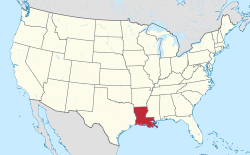Cottonport, Louisiana | |
|---|---|
Town | |
 Location of Cottonport in Avoyelles Parish, Louisiana. | |
 Location of Louisiana in the United States | |
| Coordinates: 30°59′50″N92°03′03″W / 30.99722°N 92.05083°W [1] | |
| Country | United States |
| State | Louisiana |
| Parish | Avoyelles |
| Incorporated | 1888 |
| Area | |
• Total | 2.00 sq mi (5.19 km2) |
| • Land | 2.00 sq mi (5.19 km2) |
| • Water | 0.00 sq mi (0.00 km2) |
| Elevation | 59 ft (18 m) |
| Population (2020) | |
• Total | 2,023 |
| • Density | 1,008.98/sq mi (389.53/km2) |
| Time zone | UTC-6 (CST) |
| • Summer (DST) | UTC-5 (CDT) |
| ZIP code | 71327 [3] |
| Area code | 318 |
| FIPS code | 22-17880 |
| GNIS feature ID | 2406320 [1] |
| Website | https://townofcottonport.com |
Cottonport is a town in Avoyelles Parish, Louisiana, United States. The population was 2,006 at the 2010 census. [4]
